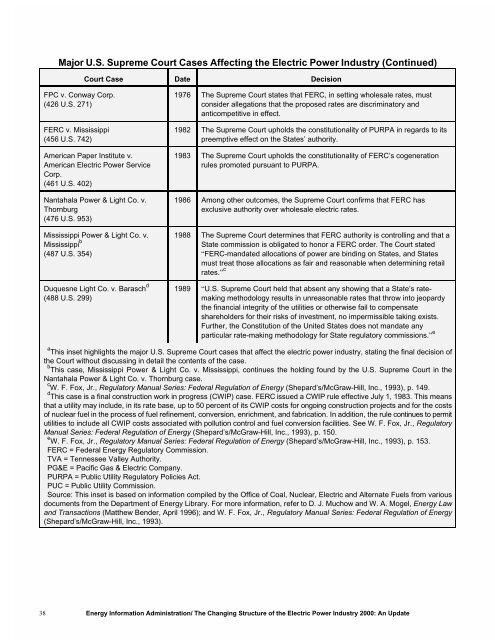The Changing Structure of the Electric Power Industry 2000: An ... - EIA
The Changing Structure of the Electric Power Industry 2000: An ... - EIA
The Changing Structure of the Electric Power Industry 2000: An ... - EIA
Create successful ePaper yourself
Turn your PDF publications into a flip-book with our unique Google optimized e-Paper software.
Major U.S. Supreme Court Cases Affecting <strong>the</strong> <strong>Electric</strong> <strong>Power</strong> <strong>Industry</strong> (Continued)<br />
FPC v. Conway Corp.<br />
(426 U.S. 271)<br />
FERC v. Mississippi<br />
(456 U.S. 742)<br />
38<br />
Court Case Date Decision<br />
American Paper Institute v.<br />
American <strong>Electric</strong> <strong>Power</strong> Service<br />
Corp.<br />
(461 U.S. 402)<br />
Nantahala <strong>Power</strong> & Light Co. v.<br />
Thornburg<br />
(476 U.S. 953)<br />
Mississippi <strong>Power</strong> & Light Co. v.<br />
Mississippi b<br />
(487 U.S. 354)<br />
Duquesne Light Co. v. Barasch d<br />
(488 U.S. 299)<br />
1976 <strong>The</strong> Supreme Court states that FERC, in setting wholesale rates, must<br />
consider allegations that <strong>the</strong> proposed rates are discriminatory and<br />
anticompetitive in effect.<br />
1982 <strong>The</strong> Supreme Court upholds <strong>the</strong> constitutionality <strong>of</strong> PURPA in regards to its<br />
preemptive effect on <strong>the</strong> States’ authority.<br />
1983 <strong>The</strong> Supreme Court upholds <strong>the</strong> constitutionality <strong>of</strong> FERC’s cogeneration<br />
rules promoted pursuant to PURPA.<br />
1986 Among o<strong>the</strong>r outcomes, <strong>the</strong> Supreme Court confirms that FERC has<br />
exclusive authority over wholesale electric rates.<br />
1988 <strong>The</strong> Supreme Court determines that FERC authority is controlling and that a<br />
State commission is obligated to honor a FERC order. <strong>The</strong> Court stated<br />
“FERC-mandated allocations <strong>of</strong> power are binding on States, and States<br />
must treat those allocations as fair and reasonable when determining retail<br />
rates.” c<br />
1989 “U.S. Supreme Court held that absent any showing that a State’s ratemaking<br />
methodology results in unreasonable rates that throw into jeopardy<br />
<strong>the</strong> financial integrity <strong>of</strong> <strong>the</strong> utilities or o<strong>the</strong>rwise fail to compensate<br />
shareholders for <strong>the</strong>ir risks <strong>of</strong> investment, no impermissible taking exists.<br />
Fur<strong>the</strong>r, <strong>the</strong> Constitution <strong>of</strong> <strong>the</strong> United States does not mandate any<br />
particular rate-making methodology for State regulatory commissions.” e<br />
a This inset highlights <strong>the</strong> major U.S. Supreme Court cases that affect <strong>the</strong> electric power industry, stating <strong>the</strong> final decision <strong>of</strong><br />
<strong>the</strong> Court without discussing in detail <strong>the</strong> contents <strong>of</strong> <strong>the</strong> case.<br />
b This case, Mississippi <strong>Power</strong> & Light Co. v. Mississippi, continues <strong>the</strong> holding found by <strong>the</strong> U.S. Supreme Court in <strong>the</strong><br />
Nantahala <strong>Power</strong> & Light Co. v. Thornburg case.<br />
c W. F. Fox, Jr., Regulatory Manual Series: Federal Regulation <strong>of</strong> Energy (Shepard’s/McGraw-Hill, Inc., 1993), p. 149.<br />
d This case is a final construction work in progress (CWIP) case. FERC issued a CWIP rule effective July 1, 1983. This means<br />
that a utility may include, in its rate base, up to 50 percent <strong>of</strong> its CWIP costs for ongoing construction projects and for <strong>the</strong> costs<br />
<strong>of</strong> nuclear fuel in <strong>the</strong> process <strong>of</strong> fuel refinement, conversion, enrichment, and fabrication. In addition, <strong>the</strong> rule continues to permit<br />
utilities to include all CWIP costs associated with pollution control and fuel conversion facilities. See W. F. Fox, Jr., Regulatory<br />
Manual Series: Federal Regulation <strong>of</strong> Energy (Shepard’s/McGraw-Hill, Inc., 1993), p. 150.<br />
e W. F. Fox, Jr., Regulatory Manual Series: Federal Regulation <strong>of</strong> Energy (Shepard’s/McGraw-Hill, Inc., 1993), p. 153.<br />
FERC = Federal Energy Regulatory Commission.<br />
TVA = Tennessee Valley Authority.<br />
PG&E = Pacific Gas & <strong>Electric</strong> Company.<br />
PURPA = Public Utility Regulatory Policies Act.<br />
PUC = Public Utility Commission.<br />
Source: This inset is based on information compiled by <strong>the</strong> Office <strong>of</strong> Coal, Nuclear, <strong>Electric</strong> and Alternate Fuels from various<br />
documents from <strong>the</strong> Department <strong>of</strong> Energy Library. For more information, refer to D. J. Muchow and W. A. Mogel, Energy Law<br />
and Transactions (Mat<strong>the</strong>w Bender, April 1996); and W. F. Fox, Jr., Regulatory Manual Series: Federal Regulation <strong>of</strong> Energy<br />
(Shepard’s/McGraw-Hill, Inc., 1993).<br />
Energy Information Administration/ <strong>The</strong> <strong>Changing</strong> <strong>Structure</strong> <strong>of</strong> <strong>the</strong> <strong>Electric</strong> <strong>Power</strong> <strong>Industry</strong> <strong>2000</strong>: <strong>An</strong> Update

















